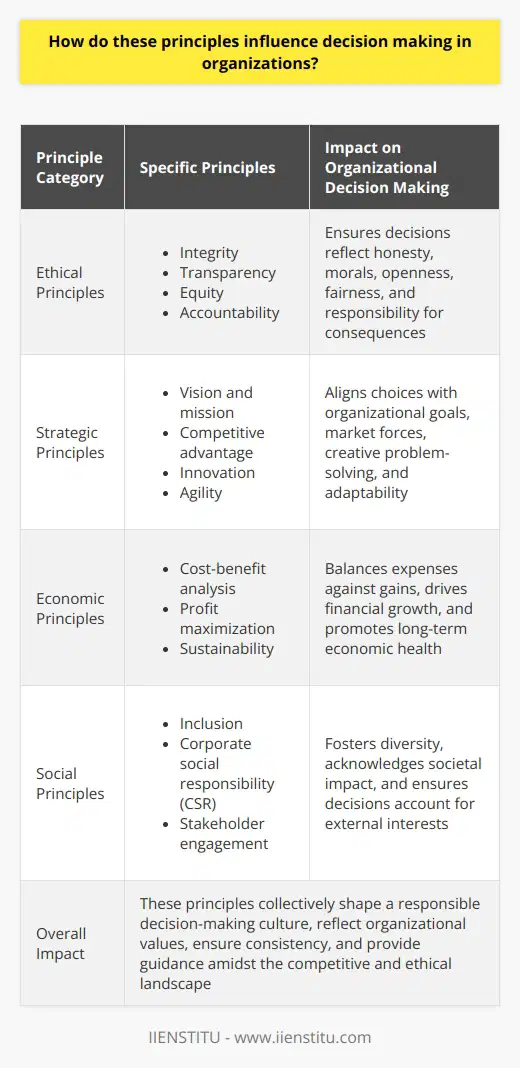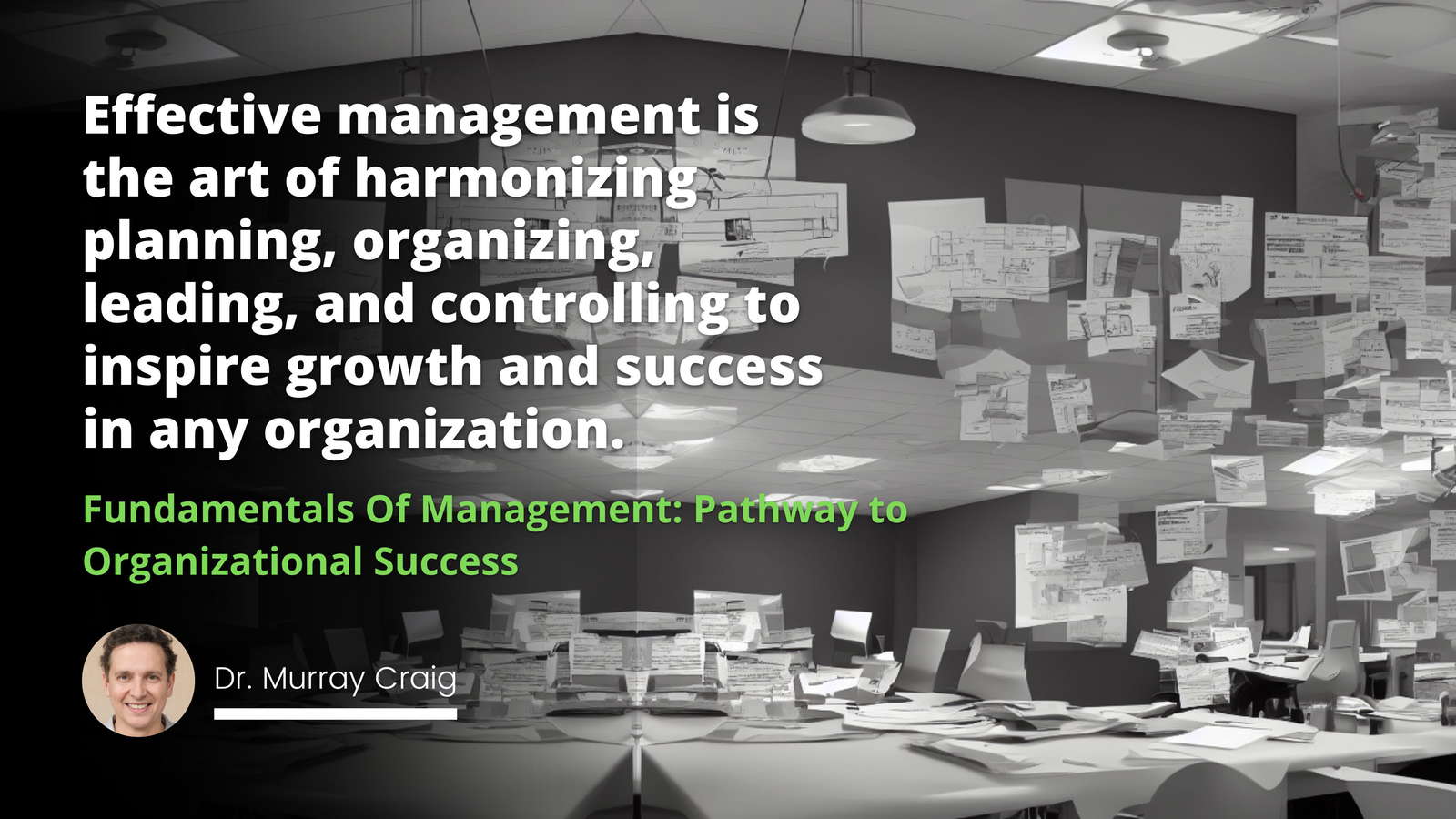
The field of organizational management constitutes a fundamental aspect of effectively steering a company or institution towards its strategic objectives. Organizational Management encompasses a variety of tasks including planning, directing, organizing, and overseeing resources to achieve organizational goals. Recognizing and adhering to the core principles of management provide a scaffold upon which organizational success is built.
This integral understanding forms the backbone of both traditional MBA course material and contemporary online courses in management. The importance of such knowledge lies in the ability to adapt fundamental management philosophies to the ever-evolving landscape of the modern business environment.
The Evolution of Organizational Management

Historical Perspective: The inception and evolution of organizational management can be traced back to the industrial revolution, where the complexity of operations necessitated a structured approach to oversee factory functions. Early theories, such as Taylor's Scientific Management, emphasized maximizing efficiency through worker specialization. However, as industries expanded, the nuances of human behavior and organizational dynamics began to take center stage, expanding the scope of management thought.
Shifts in Management Philosophies Over Time: Throughout the 20th century, management philosophies evolved significantly, incorporating psychosocial dynamics, motivation theories, and the importance of leadership. The emergence of human relations theory in the mid-1900s marks a pivotal shift from mechanistic views of management to more people-centered approaches. These philosophies further evolved into contemporary holistic management principles that encompass strategic vision, ethical consideration, and sustainability.
Reflection on Current Trends: Today, organizational management draws upon a rich tapestry of theories, extending into agile management practices and inclusive corporate cultures. The advancement of technology and globalization has prompted a recalibration of management techniques, proving that the field is both dynamic in nature and responsive to the external business climate.
Core Principles of Management

Planning and Goal Setting
Strategic Vision and Tactical Objectives: The cornerstone of any successful management framework is the establishment of a clear strategic vision. This vision cascades into tactical objectives that align with the company's long-term aims. Developing a roadmap not only provides direction but enables the organization to measure progress against pre-defined milestones, thereby ensuring all efforts contribute meaningfully to the larger goals.
Importance of Aligning Goals with Organizational Mission: Aligning individual and departmental objectives with the overarching mission of the organization ensures coherence and synergy in pursuit of common ends. This alignment is critical for maintaining a unified direction amid the complexity of operational tasks and fosters a sense of shared purpose among employees.
Organizing Resources and Structure
Organizational Structure and Design: The architecture of an organization's structure plays a pivotal role in determining its efficiency and effectiveness. Whether it follows a flat, hierarchical, or networked model, the organizational design must support communication, facilitate swift decision-making, and align with the company's strategic intentions.
Allocation of Resources and Responsibilities: Efficient allocation of resources, including capital, personnel, and information, directly contributes to an organization's performance. Distributing responsibilities in a manner that leverages the strengths of team members and departments is a delicate balance, vital for optimizing outcomes.
Leading and Motivating

Key Leadership Qualities in Management: Effective leadership requires a blend of emotional intelligence, strategic thinking, and communication skills. Leaders in management roles must motivate their teams, set a positive example, and guide the organization through challenges and opportunities.
Techniques for Motivating Personnel: Motivation techniques range from creating a culture of recognition and reward to providing opportunities for professional growth and autonomy. Tailoring these techniques to the unique makeup of the workforce can drive performance and job satisfaction.
Controlling and Performance Management
Monitoring Organizational Performance: Continual monitoring of performance against standards is essential to maintain organizational health. This involves setting measurable benchmarks and using key performance indicators (KPIs) to assess and manage productivity.
Methods for Ensuring Accountability and Adaptation: Effective control mechanisms also include establishing accountability structures. Managers need to foster an environment where transparent feedback is encouraged, and adaptation is embedded into the culture, in order to navigate the organization through the evolving business landscape.
What is Management in an Organization?

The Role of a Manager in Various Organizational Contexts: The role of a manager can vary significantly depending on the organizational context, encompassing everything from operational oversight to strategic development. What remains constant is the necessity of a well-rounded managerial approach that can navigate the complexities inherent to each unique organizational setting.
Balancing Strategic Planning with Operational Management: It is incumbent upon managers to strike a delicate balance between enacting long-term strategic plans and managing day-to-day operations. This requires a bespoke blend of foresight and adaptability, ensuring that immediate tasks do not overshadow or derail from the strategic trajectory.
The Impact of Leadership in Management
Transformational vs. Transactional Leadership: Two dominant leadership styles in management are transformational and transactional. Transformational leadership inspires and motivates employees to transcend their own self-interests for the good of the organization, while transactional leadership is centered on the exchange process between the leader and their followers, often utilizing rewards and penalties to drive performance.
Leadership Styles and Organizational Culture: A leader's style can significantly influence organizational culture, which in turn impacts employee engagement, customer experiences, and business outcomes. Adapting leadership approaches to be more congruent with organizational values and the needs of employees can lead to a more harmonious and effective organization.
Developing Leadership Skills within an Organizational Context: Investing in the development of leadership skills at all organizational levels is not just beneficial, but necessary for fostering a robust management culture. Strategies for leadership development may include mentorship programs, training seminars, and rotational assignments to ensure that leadership potential is identified and nurtured within the organization.
Advanced Management Techniques
Innovations in Management Strategies: Contemporary organizational management is continuously influenced by technological advancements and innovative thought leadership. Concepts like Lean Management and Six Sigma have contributed to streamlining processes and eliminating waste from operations, signifying an ongoing pursuit of efficiency.
Integrating Technology in Management Practices: The integration of technology into management practices has revolutionized the way managers operate. From data analytics to artificial intelligence, technology has become an indispensable tool for decision-making, communication, and project management.
Adapting to Global Changes in Business Practices: In an ever-globalizing economy, adaptability is paramount. Managers must stay informed regarding global trends and cultural sensibilities to navigate the international marketplace adeptly. This means adjusting management practices to be more globally inclusive and responsive to diverse business environments.
Case Studies
Real-World Examples of Effective Organizational Management
Case studies serve as a rich resource for understanding the practical application of organizational management principles. Companies like Google, with its innovation-driven culture, or Toyota, with its storied Toyota Production System, provide tangible examples of how management principles can be effectively applied for organizational success.
Analysis of Leadership Strategies in Renowned Companies
Analyzing the leadership strategies of renowned companies offers valuable insights into the flexible and varied ways leadership can impact an organization. Microsoft's revitalization under Satya Nadella's inclusive leadership style, and Apple's sustained innovation under the meticulous care of Tim Cook, serve as compelling studies for aspiring leaders and managers.
Conclusion
Summary of Core Principles of Organizational Management
This article has traversed the multifaceted landscape of organizational management, from its historical roots to advanced practices, underscoring the essential role of its core principles. These tenets of planning, organizing, leading, and controlling remain the bedrock upon which effective management rests.
The Continuous Evolution of Management Practices
Recognizing that organizational management is a discipline in constant evolution, managers and leaders must engage with ongoing learning and development to stay abreast of emerging trends and emerging management techniques.
Encouraging Further Learning and Adaptation in the Field
It is incumbent on management professionals to cultivate a mindset of continuous learning and adaptability. As such, individuals in the field are encouraged to further their knowledge through formal education like MBA courses or self-paced online courses to maintain a competitive edge in a rapidly changing business environment.
Frequently Asked Questions
What are the core principles of organizational management from an academic perspective?
Understanding Organizational Management
Organizational management refers to the art of steering an organization towards its goals. Academics highlight several core principles that guide this practice. These principles underpin effective leadership, strategic planning, and organizational success.
Planning and Goal Setting
Organizations need clear objectives. Goals offer direction. They guide decision-making. Managers plan to achieve these goals. This is the organization's roadmap. Planning entails resource allocation. It involves setting timelines. Managers must prioritize tasks throughout this process.
Organizing Resources Effectively
Management organizes resources. This includes people, capital, and information. Effective organization seeks efficiency. It maximizes productivity. Organizational design plays a key role here. It dictates the structure of workflows. It addresses division of labor, departmentalization, and coordination amongst units.
Staffing and Human Resource Management
People are critical resources. Staffing involves recruitment, hiring, and training. Human Resource Management ensures the right fit. It focuses on employee development. Staffing requires understanding job requirements. It also involves forecasting future needs. Effective HR practices boost morale. They enhance retention.
Directing and Leadership
Direction involves leading the workforce. Leaders communicate the vision. They motivate the team. Successful leaders inspire action. They understand individual and group dynamics. Management must provide clear instructions. Feedback is essential. It ensures tasks meet certain standards.
Controlling and Performance Evaluation
Control ensures activities align with plans. It entails setting performance standards. Managers must assess actual performance. They compare results with goals. Monitoring systems help in this regard. Control allows for corrective actions. It maintains organizational order.
Effective Communication
Communication is vital. It facilitates information flow. Managers must communicate clearly. They must also listen effectively. Communication supports all other management functions. It ensures team understanding. It fosters collaboration.
Decision Making and Problem Solving
Decision making is constant. Problems arise frequently. Managers must analyze situations. They weigh options critically. Good decisions support organizational objectives. Problem-solving requires creativity. It demands the ability to adapt.
Innovation and Change Management
Organizations must innovate to remain competitive. Change management guides this process. It prepares the organization for transitions. Managers must address resistance. They cultivate a culture of continuous improvement.
Ethical Practices and Social Responsibility
Ethics underpin all activities. Managers uphold moral values. They ensure integrity in transactions. Social responsibility extends beyond the firm. It considers the impact on communities. Sustainable practices are important. They ensure long-term success.
International Perspective and Diversity Management
Globalization affects management. Managers must appreciate cultural differences. They navigate global markets. Diversity management optimizes varied workforce talents. It enriches creativity. It enhances problem-solving.
Implementing these core principles proves challenging. It demands diligence. Management theories evolve. Managers must stay informed. They integrate new ideas continually. This maintains organizational relevance. It ensures sustainable success.

How do these principles influence decision making in organizations?
Organizational Decision Making and Guiding Principles
Organizations operate on core principles. These dictate decision-making processes. Management often turns to these principles. They offer a foundation for choices. Ethical norms shape this foundation significantly. They also provide a moral framework for decisions.
Ethical Principles
Integrity stands crucial in organizational choices. It ensures decisions reflect honesty and morals. Leaders prioritize integrity above expediency. Transparency requires openness in decision processes. Stakeholders demand this of modern organizations. Employees, customers, and partners value this trait. Equity seeks fairness across the board. It promotes justice in decision outcomes. Accountability assigns responsibility to decision-makers. It highlights the importance of owning consequences.
Strategic Principles
Vision and mission guide long-term decisions. They align choices with organizational goals. Competitive advantage influences strategic moves. Organizations aim to outperform rivals. They ensure tactics consider market forces. Innovation encourages creative problem-solving. It pushes for novel solutions in decision-making. Agility emphasizes flexibility and adaptability. Quick, responsive decision-making thrives on this principle.
Economic Principles
Cost-benefit analysis underpins fiscal decisions. Organizations weigh expenses against gains. Leaders seek maximum benefit for minimum cost. Profit maximization involves boosting financial gains. This principle often drives commercial entities. Decisions revolve around improving the bottom line. Sustainability addresses long-term economic health. Decisions incorporate environmental and social considerations.
Social Principles
Inclusion guides equitable decision-making. It fosters diversity and representation. Decisions strive to consider various perspectives. Corporate social responsibility (CSR) influences organizational behavior. Organizations acknowledge their impact on society. Decisions reflect a commitment to the greater good. Stakeholder engagement promotes inclusive dialogues. It ensures decisions account for external interests.
Impact on Organizational Decisions
These principles form the decision-making fabric. They serve as criteria for evaluating options. Leaders consider them in policy formation. They ground choices in more than immediate returns. Every principle colors decisions differently. Integrity leads to trustworthiness. Transparency builds confidence. Equity ensures fairness. Accountability underscores consequence management.
Strategic principles align with long-term visions. Vision and mission ensure cohesion. Competitive advantage focuses on the market context. Innovation champions breakthroughs. Agility permits rapid realignment.
Economic principles balance books. Cost-benefit analysis brings financial prudence. Profit maximization drives enterprise-focused decisions. Sustainability promotes enduring success.
Social principles anchor decisions in communal contexts. Inclusion upholds diversity. CSR showcases organizational values. Stakeholder engagement fosters cooperation.
Together, these principles shape a responsible decision-making culture. They reflect organizational values and ensure consistency. In a complex business environment, they provide necessary guidance. They act as a compass amidst the competitive and ethical landscape.

Can you elucidate how core principles of organizational management could potentially impact organizational culture?
Organizational Management and Culture
Organizational management stands at the helm of any company. It steers all aspects, from strategy to daily operations. Core principles underpinning it dictate the organizational culture fundamentally. Culture embodies the shared values, beliefs, and practices within a company. It affects every employee's experience and behavior. Thus, the principles of management can drastically shape this culture.
The Impact of Vision and Leadership
Vision articulates a company's future aspirations. It serves as a north star, guiding strategies and actions. Strong leadership mobilizes this vision, inspiring stakeholders. Leaders' behaviors and values permeate the entire organization. They set a behavioral benchmark for all employees. Clear vision and exemplary leadership foster a culture of unity and purpose. They align individual goals with the collective mission. This alignment is at the heart of a robust organizational culture.
The Role of Communication
Communication is another core principle crucial for culture. Transparent, open communication channels support trust. They encourage dialogue across all organizational levels. Managers who communicate effectively foster an inclusive culture. They value everyone's input and feedback. Such practices build a sense of belonging and engagement. Moreover, good communication ensures the workforce understands the organizational values. It reinforces cultural norms through everyday interaction.
Decision-Making and Autonomy
Decision-making is central to management principles. It affects how empowerment and autonomy flourish within a culture. Hierarchical decision-making can create a culture of dependency. In contrast, participative approaches promote a collaborative environment. Employees gain autonomy and a voice in important matters. They feel valued and responsible for outcomes. Such involvement strengthens a culture of accountability and innovation.
Accountability Structure
Accountability structures shape how responsibility is assigned. Firm but fair accountability builds a culture of reliability and integrity. Everyone knows the expectations and the consequences of actions. These standards encourage a culture focused on continuous improvement. Performance-based cultures emerge from effective accountability mechanisms.
Rewards and Recognition
Rewards and recognition are powerful cultural tools. Positive reinforcement for achieving goals strengthens desired behaviors. It embeds these behaviors into the organizational fabric. Management must align rewards with the cultural values it aspires to. Recognizing team efforts, and not just individual success, fosters a collaborative culture. It can also cultivate a high-performance culture focused on collective wins.
Adaptability and Learning
Adaptability and learning are critical in fast-paced environments. They shape cultures that are dynamic and resilient. Organizations that embrace learning facilitate growth and innovation. Cultures that do not evolve can stagnate. Management that encourages adaptability fosters a culture open to change.
- Vision aligns strategy and actions
- Leadership sets behavioral benchmarks
- Transparent communication supports trust
- Participative decision-making promotes collaboration
- Accountability ensures reliability
- Rewards embed desired behaviors
- Learning leads to innovation
Effective organizational management acknowledges the symbiotic relationship with culture. Principles applied consciously can lead to a positive, productive atmosphere. The culture, in turn, sustains management's efforts to attain organizational goals. Every action by management is a brush stroke in the larger picture of organizational culture. Thus, understanding and navigating these principles is crucial. They have the potential to build a legacy of excellence for any organization.



